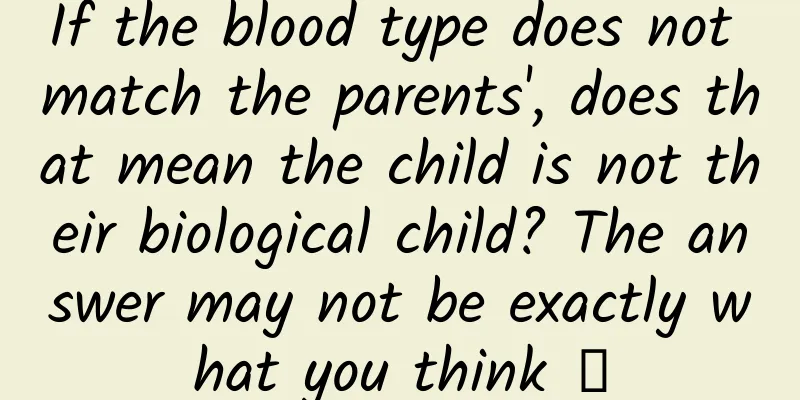If the blood type does not match the parents', does that mean the child is not their biological child? The answer may not be exactly what you think →

|
After donating blood, a female college student discovered that her blood type did not match that of her parents. Her parents were type AB and type O respectively. According to the laws of inheritance, her blood type should be type A or type B, but her blood type was AB. This incident once caused the family relationship to fall into embarrassment and pain. Later, a paternity test confirmed that the girl was indeed the biological daughter of her parents. So, why does this blood type mismatch occur? 01Basic knowledge of blood type Blood type refers to the type of antigens on the surface of blood components such as red blood cells, white blood cells, and platelets. Among them, the most common ABO blood type is one of the red blood cell blood type systems and is also the earliest confirmed type in the human blood type system. The ABO blood type is determined by the three alleles A, B, and O on the autosomes. A and B are dominant genes, and O is a recessive gene. They are passed down according to the laws of inheritance. Image source: Zhongshan Central Blood Station. At the relative positions of a pair of autosomes, the three alleles A, B, and O can rotate to occupy the positions, so they can be combined into 6 genotypes: AA, AO, BB, BO, AB, and OO. According to genetic principles, the AO gene combination only presents the phenotype of the A gene, so the blood type is type A. Therefore, the 6 gene combinations can only be expressed as the following 4 blood types. Image source: Douyiquaner In my country, blood types A, B and O account for about 30% of the population, and AB accounts for about 10%. The blood type combination of a spouse directly affects the possible blood type of their children. According to the laws of genetics, parents with different blood type combinations have the following possibilities of producing children with blood types: In the example at the beginning of this article, according to conventional genetics, when the parents are type AB and type O respectively, they cannot give birth to an AB type child. Why does a paternity test confirm that the child is his or her own? 02Blood type and blood relationship When a child's blood type does not conform to the normal genetic rules, it does not necessarily mean that they are not biologically related. Although blood type is determined by genes, the blood types between parents and children are not completely genetically related. Gene mutations, gene cross-recombination , etc. may cause differences in blood types between children and parents. In the above case, the truth behind the mismatch between the daughter's blood type and her parents' is that the girl's father's AB type gene mutated, and the A gene and B gene appeared on the same chromosome at the same time , and were all inherited by the daughter, and then combined with another chromosome inherited from the mother to form a complete diploid, making the daughter's blood type AB type. Normal AB blood type individual pattern diagram Normal inheritance and gene mutation inheritance In clinical practice, the probability of both A gene and B gene being on the same chromosome is about 1 in 170,000 to 1 in 580,000. This situation is called cis AB blood type and usually does not affect the individual's life. Therefore, blood type is only one factor in parent-child relationship identification, not the only basis. Modern parent-child relationship identification technology is quite mature. Parent-child relationship can be accurately determined through DNA sequence comparison without interference from blood type. Therefore, it is recommended to conduct paternity testing through professional institutions. 03Rare blood types In addition to the ABO blood group system, the Rh blood group system is also an important red blood cell blood group system. Rh is the abbreviation of the name of the rhesus monkey (Rhesus Macacus). When the D antigen is present on the red blood cells, it is called Rh positive, represented by Rh (+); when the D antigen is absent, it is called Rh negative, represented by Rh (-). The Rh (-) gene is a recessive gene . Only when the Rh (+) parents also carry the Rh (-) gene and pass on the Rh (-) to their offspring at the same time, their children can show Rh (-). Rh blood type inheritance pattern chart | Source: Zhihu In China, about 99% of the population has Rh positive blood type, and Rh negative blood type accounts for only about 1% . Therefore, Rh negative blood type is very rare, as precious as giant pandas, and is commonly known as "panda blood". In addition, there are some extremely rare blood types, such as "dinosaur blood" - Bombay blood type, "golden blood" - Rhnull, A3 blood type (currently only one person in Nanjing, China) and small p blood type. As of November 2022, humans have discovered 44 blood type systems. 04Blood type and blood transfusion In clinical blood transfusion and organ transplantation, the ABO blood type system is the most important. In addition to the four common phenotypes of A, B, O and AB, there are many rare subtypes of ABO blood type, among which the subtypes of A blood type are divided into A2, A3, Am, Ax, Ael, etc. Therefore, accurate identification of ABO blood type and subtype is the key to ensuring clinical safe blood use. If the blood type does not match during blood transfusion, the recipient 's red blood cells will agglomerate into clusters, block small blood vessels, cause blood circulation disorders, and can be fatal in severe cases . Modern serological and molecular biological detection techniques can accurately identify these subtypes. Rh blood type antibodies are the main factor causing hemolytic transfusion reactions and hemolytic disease of newborn (HDN). For women who have a history of blood transfusion, pregnancy or miscarriage who are pregnant again, they should pay more attention to the identification of Rh blood type antigens during the next pregnancy and regularly monitor the titer of antibodies. If an Rh-negative pregnant woman has an Rh-positive fetus for the first time, the fetal red blood cells will enter the mother in the late pregnancy, causing the mother to produce Rh antibodies. If the mother is pregnant with an Rh-positive fetus again, neonatal hemolysis will occur. In clinical practice, timely injection of specific anti-RhD immunoglobulin can prevent hemolysis of the second fetus. References [1]Xue Yang, Li Chao, Xin Wenlong, et al. Identification of novel variants in exon 1 of ABO blood type gene[J]. Chinese Journal of Experimental Hematology, 2024, 32(4): 1212-1216. [2] Wang Lin, Jiang Tao, Yang Shiming, et al. Serological identification of Rh anti-C antibodies and their clinical significance[J]. Journal of Cellular and Molecular Immunology, 2024: first published online. Author: Clinical Medicine of Harbin Medical University, Dai Mingcheng Editor: Xiaoxiao Dandelion |
<<: Someone got poisoned after eating toads! Don't be greedy for these things →
>>: The color of the Earth is changing, and it's not a good thing...
Recommend
When it comes to college entrance examination poster copywriting, who do you admire the most? ?
A special month of June, with Children’s Day , Gr...
What did the legendary good community do right?
On the evening of June 29, 2016, Qiu Ye, associat...
Implementing iPhone X’s FaceID feature with Python and deep learning
For Apple fans, the most discussed topic about th...
Qianwanshe's new short video money-making project: Douyin emoji package leads to 20,000 yuan a month
Moreover, I didn’t invest a penny. Since the emot...
Fishing for fish can cause shoulder joint disease? Experts remind: Fishing can improve your health and mind, but you should also pay attention to the method
Grandpa Cao is over 60 years old. After retiring ...
How do people wear masks in schools? What are the principles for campus disinfection? Chinese CDC experts explain five details about returning to school
Beijing's senior high school and junior high ...
Well-known female star becomes "Electronic Dora"! What is the reason for incomplete glottal closure?
Recently, #秦岚声带难过# has become a hot search topic,...
Upgrade! Apple iOS 15.2 is officially released: fixes a lot of bugs and adds many new features
[[440213]] Apple today released iOS 15.2 and iPad...
Why is Liu Cixin’s “The Three-Body Problem” so popular in the Internet circle?
Although the Hugo Awards were interfered with by ...
Chongqing finally welcomes artificial rainfall! Experts: This cloud has been "audited"
In recent days, News of high temperature and drou...
Shen Liang's internal training video tutorial on futures starting point trading system (only talk about the dry goods and no nonsense)
Chen Liang's Start-up Point Trading System Fu...
This galaxy is "bombarding" another galaxy with plasma streams
A weird black hole is spewing plasma into a nearb...
Use CocoaPods to print and receive messages for WeChat integrated SDK
Recommendation This article introduces a set of r...
How can business services achieve positive growth in search promotion effects? Optimization ideas reference
1. Background Main business: Business service ind...
It’s 2022, do you want to see something tiger-like?
The Year of the Tiger is here, Fat Tiger wishes y...









